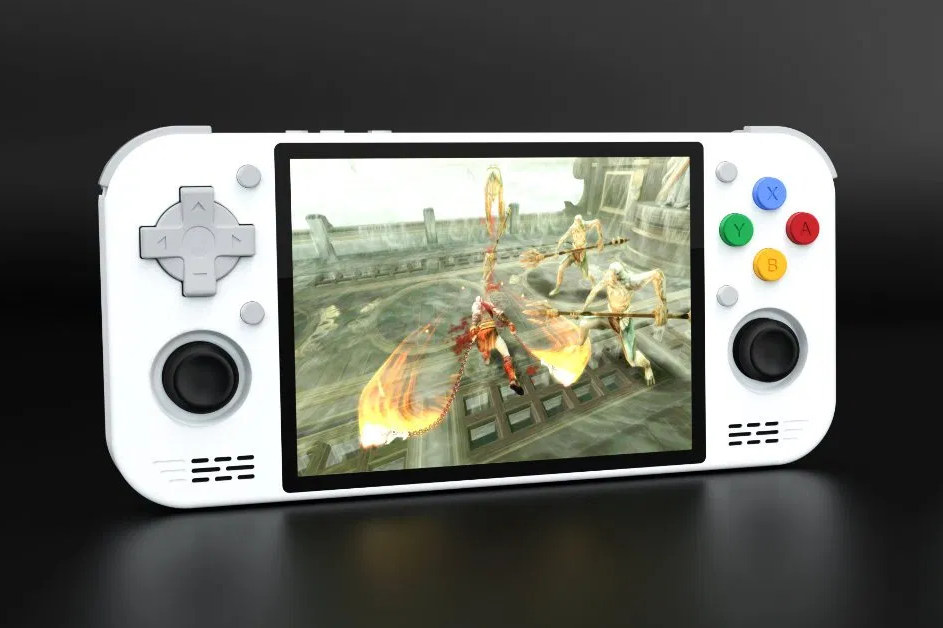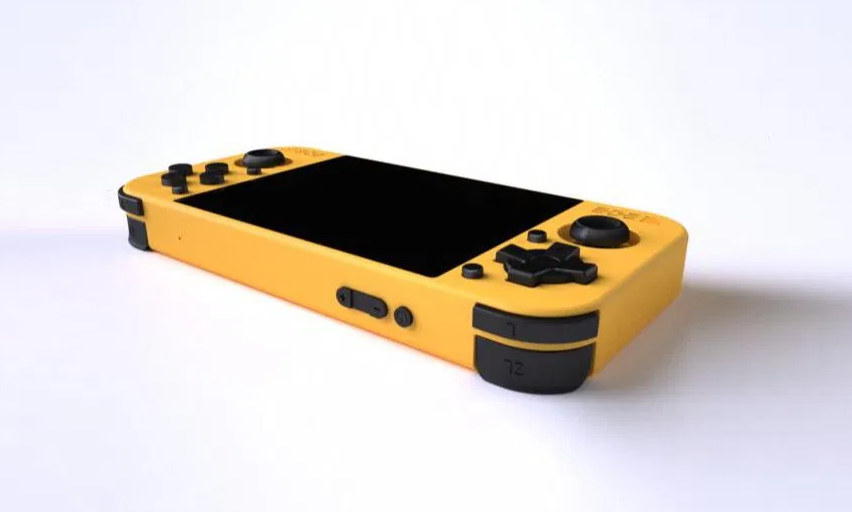Hardkernel recently unveiled plans to launch ODROID-Go Super portable retro-gaming console with a larger 5-inch display at the end of January. The console is still based on the relatively low-end Rockchip RK3326 quad-core Cortex-A35 processor coupled with just 1GB RAM found in ODROID-Go Advance.
It does the job for the emulators targetted by the platform, but for a wider range of emulators, a faster processor, and more memory would be nice to have. That’s what the developers of KTR1 portable game console aim to achieve with a much more powerful Amlogic S922X hexa-core Cortex-A73/A55 processor and up to 4GB RAM.
KTR1 preliminary specifications:
- SoC – Amlogic S922X hexa-core big.LITTLE processor with 4x Arm Cortex A73 cores @ up to 1.8 GHz, 2x Arm Cortex A53 cores @ 1.9 GHz, Arm Mali-G52MP4 GPU @ 846MHz; 12nm manufacturing process
- System Memory – 2GB or 4GB LPDDR4 RAM
- Storage – 16 to 128GB eMMC flash, microSD card slot
- Display – 4-inch touchscreen display with 800×600 resolution (4:3 aspect ratio)
- Video Output – Mini HDMI port
- Audio – Stereo speaker, 3.5mm audio jack
- Connectivity – Dual-band 802.11 b/g/n/ac WiFi 5 and Bluetooth
- User inputs – “Full buttons with LR3”: dual analog sticks, R1/L1, R2/L2, R3/L3 buttons, D-pad, ABXY buttons, and four more buttons, plus a volume rocker and power button.
- Misc – Vibration motor
- Battery – 4,000 mAh
- Power Supply – Via USB-C with 25W fast charge support
- Dimensions – 153 x 76 x 18 mm
- Weight – TBD
The console will initially run Android 9.0 with Vulkan drivers for 3D graphics acceleration, but if the device performs well, and battery life is not a disaster, we should certainly see Linux-based firmware such Batocera.Linux, Lakka, RetroArch, etc… will certainly be ported to those platforms.
Since the KT R1 will be much more powerful than ODROID-Go Advance/Super, it should be able to run more games including God of War (PSP), Shenmue 2 all capable of running at 60fps on this type of platform. However, PS2 emulation may still not be practical as even with the faster processor one can only hope for a dozen or so fps.
KTR1 portable retro-gaming console is expected to launch on Indiegogo in Q1 2021, and the price floated on Reddit is around $200, so much more expensive than the $80 ODROID-Go Super, but that should be expected due to the higher-end processor, and extra memory and storage. There was no confirmation of the exact RAM/storage configuration for this price though.
Via Obscure Handhelds

Jean-Luc started CNX Software in 2010 as a part-time endeavor, before quitting his job as a software engineering manager, and starting to write daily news, and reviews full time later in 2011.
Support CNX Software! Donate via cryptocurrencies, become a Patron on Patreon, or purchase goods on Amazon or Aliexpress. We also use affiliate links in articles to earn commissions if you make a purchase after clicking on those links.






Interesting handheld with a beefy CPU. I’d prefer if hardkernel would’ve released it instead of an unknown company.
it have built in wifi/bt and type C for power. definitely not an odroid handheld.
“The bottom edge of the device has a headphone jack, USB-C charge port and a mini HDMI output. Somewhere on the device there will also be a tray for a sim and MicroSD card.”
There’s that HDMI output someone was looking for.
The Amlogic S922X does not support dual displays. If there is an HDMI output, then they would have to use composite video (CVBS) to drive the LCD.
Why not using MIPI DSI for the LCD?
When I inquired about S922X MIPI DSI, I was told there were “issues”. I do not know if they have been addressed in software/silicon revision since I inquired.
Also relevant is that in the ODROID-GO Super (OGS) announcement, HardKernel stated “we couldn’t find any LCD manufacturer who can build a 4 ~ 5 inch display with 4:3 ratio”. The OGS uses DSI.
Based on this information, I concluded it was unlikely (though not impossible) that a DSI display was being used. I considered it more likely that information reported on a pre-production product was simply inaccurate, and there is not actually a functional HDMI connector. Time will tell.
For completeness, I will also state that I do not think the display is going to the primary concern for this device. The S922X is well known by developers at this point, and I think the primary concerns are going to be power and thermals. Just look at the heat sink on N2.
> Just look at the heat sink on N2.
The Odroid N2 is stable at 2.2 ghz even with 35c ambient. This S922 is only clocked at 1.8 ghz so shouldn’t have any trouble maintaining its clock.
And the only reason the Odroid heatsink is so big is because the CPU is placed at the bottom, and it’s overkill anyway.
A better thermal comparison would be the TV boxes based on the S922x. Some of which do run into trouble with thermals.
Even that is not the best comparison since it is a handheld so you are stuffing a battery, screen, and supporting circuitry into it as well, all of which add to the thermal situation.
It being a handheld also means maintaining clocks is not the only thermal concern either. The temperatures that keep the components happy, may not make your hands happy. (Unless maybe you live some place with really cold winters.)
Odd people build handheld game consoles out of the toaster marketed as RPI4 and everyone is happy. Yet the. Worry about the S922X which actually use la less power consuming SoC than the over clocked RPI4 or the standard Nvidia shield TV SoC , which also powers the Nintendo switch. But why let facts get in the way.
Recently on the Pine64 forums it was asked why don’t they just adopt a high performance SoC such as Amlogic S992X for their next PinePhone.
Pine64 responded with 2 concerns about
integrating a display and battery drain, as echoed by crashoverride, above.
Pine64 are invested in open source and Rockchip. The S922X is Cool running and less power consuming SoC . The latest revision runs at 2.2 GHz standard and Odroid board first batch over clocked to 2.4GHZ.
The KT R1 experienced designer has no LCD problems about the SoC, I prefer his real life design experience.
It is nice to see somebody attempt such a product, however since we are not ignoring the fact that this isn’t Nintendo or Nvidia that we are talking about here, nor is it a one off DIY project.
The fact that thermals may be a non trivial point to consider for a small company in developing such a commercial product using a SoC that wasn’t designed for this usage, seems kind of a valid and reasonable subject of discussion.
The facts remain the S922X consumes less power and produces less heat than the Toaster RPI 4 , Nvidia shield TV , Nintendo Switch which runs the Nvidia SoC. If handhelds running hotter SoC chips are possibility. Then a cooler operating S922X device is very do able.
People can run Amlogic down all they want but the Allwinner H616 , H313 are cookers. The new Rockchip have yet to hit market so will take time on software support.
Their anti Amlogic will not stop progress.
What it needs is when it is charging the battery the device can still use air mouse or Bluetooth game pad to connect to TV and be used as a android TV box as the battery charges
Impressive. To have this SoC in a handheld is great.
Way to small battery but otherwise interesting.
I just bought the Retroid Pocket 2 which looks the same and has the same battery size.
I have tried to play Ultimate Ghosts ‘n Goblins on my Beelink GT-King which is a set-top box with S922X inside. Unfortunately, the experience does not good when I set the rendering resolution to 2x.
Anyway, I still hope this product could give a better experience with a dedicated firmware.
Another open source handheld to cover, Dragonbox Pyra begins shipping
I’m definitely getting one of these once they’re available to buy.